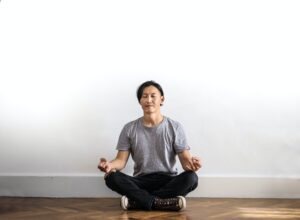Dive Into Meditation for the Ultimate COVID-19 Coping Strategy

Image by Pexels
The ever-present climate of COVID-19 has many people looking for ways they can stay physically and mentally healthy. Research and scientific data shows that the practice of meditation supports health and wellness and can be effective for managing:
- High blood pressure
- Stress and tension
- Anxiety and depression
- Pain
- Insomnia
- Smoking cessation
- IBS, ulcerative colitis, and other physical ailments
Beyond that, meditation can help you feel great and function at your personal best: peaceful, centered, relaxed, and focused. With that in mind, read on for advice from Behavioral Health Providers.
Meditation Methods and Practicing
There are many different meditation practices you could try, depending on what your goals are. Metta meditation focuses on loving-kindness towards yourself and others. Mindfulness meditation helps create mind-body awareness, and progressive (body scan) relaxation meditation increases awareness of tension areas and promotes relaxation. These three types in particular are helpful if you want to use meditation to relieve stress and develop a more positive mindset.
You also might consider pairing your meditation practice with yoga for increased benefits; as We Know Yoga explains, the two practices can work together to ease tension and promote well-being in a wide range of ways, from decreased inflammation to extended feelings of peace.
Most types of meditation are easy to do at home by yourself. You can download a meditation app or find guided tutorials on YouTube, in books, or on the web to get started. The basics of mediation are quite simple.
Set aside at least 10 minutes and find a quiet place where you will not be disturbed. Most practices suggest being seated with your feet touching the floor, having your arms and hands resting gently on your legs, and taking deep, cleansing breaths. From there, your meditation guide will lead you through the rest of the exercise.
Make a Sanctuary
Now that you’re ready to begin, try these six tips to create a beautiful sanctuary space in your own home:
- Start With a Blank Canvas. Whether you’ve set aside a whole room or just a small area, clean and declutter your space, leaving only what is necessary. A room or area that has natural light and the ability to let in fresh air is ideal and it should feel like a safe haven so you can proceed without inhibition.
- Add Seating and Define Your Space. Consider purchasing floor cushions or a supportive-yet-comfy chair to sit on. Consider adding a soft area rug.
- Use Scents To Enhance Your Experience. Add a scented candle, essential oil diffuser, or incense burner to use while you meditate. Certain scents can have beneficial effects in addition to their pleasing aromas. Lavender and eucalyptus promote relaxation; citrus scents like orange, bergamot, or lemongrass can help with anxiety; peppermint helps focus and can alleviate headaches.
- Include Some Meaningful Objects. Many people like to incorporate spirituality into their meditation and include items like a Buddha statue, crystals, a Bible, icons, or even framed photographs. Whatever you derive inspiration from is appropriate to add to your space — just keep it simple and sparse. Less is more.
- Don’t Forget About Sound. Even if you have a quiet space, it’s still nice to play soft instrumental music or soothing nature sounds while you meditate. You can try using earphones to ensure fewer distractions. Or a white noise machine can provide ambient sounds, and free up your phone or speaker to play music or your guided meditation exercises.
- Bring in the Beauty. Finally, Green Lotus Den suggests adding a few beautiful elements such as living plants, or you might add cut flowers, rocks, shells, or driftwood to round out your new sanctuary space.
Meditation is all about tuning in to yourself — your thoughts, your emotions, and your body — to observe without judgment and to be present in the moment. Whichever way you choose to design your meditation space is up to you; the only real requirement is that it fosters tranquility and facilitates your routine. Making your sacred space beautiful and inviting will encourage you to spend more time there, to linger longer, and hopefully achieve the inner peace and relaxation you are looking for during these unsettling pandemic times.
If you’re looking to add more coping tools to your belt, Behavioral Health Providers offers counseling services as well as other treatments to help you find the peace you need.
